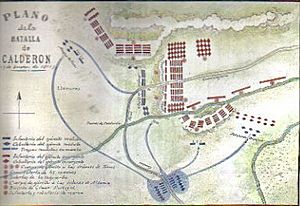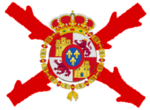Battle of Calderón Bridge facts for kids
Quick facts for kids Battle of Calderón Bridge |
|||||||
|---|---|---|---|---|---|---|---|
| Part of the Mexican War of Independence | |||||||
 Plan of the Battle of Calderón Bridge NOTE: The south is at the top, indicated by the arrow |
|||||||
|
|||||||
| Belligerents | |||||||
| Commanders and leaders | |||||||
| Miguel Hidalgo Ignacio Allende Juan Aldama Mariano Abasolo Jose Antonio Torres |
Félix María Calleja del Rey, 1st Count of Calderón Manuel de Flon † Jose de la Cruz |
||||||
| Strength | |||||||
| 90,000 - 100,000 irregulars (20,000 light cavalry) (3,000 armed with rifles) (60,000 armed with primitive weapons) 95 cannons |
5,000 - 8,000 regulars 10 cannons |
||||||
| Casualties and losses | |||||||
| 13,000 | 1,000 | ||||||
The Battle of Calderón Bridge (Spanish: Batalla del Puente de Calderón) was a very important fight during the Mexican War of Independence. It happened in January 1811 near the Calderón River in what is now Zapotlanejo, Jalisco, Mexico. This bridge was a key location that both sides wanted to control.
Nearly 100,000 Mexican freedom fighters, called insurgents, took part in the attack. They were led by important figures like Miguel Hidalgo, Ignacio Allende, Juan Aldama, and Mariano Abasolo. On the other side were the Royalist forces from New Spain. These were professional soldiers, about 5,000 to 8,000 of them, fighting for the King of Spain. Their leader was Félix María Calleja del Rey. He later received a special title, conde de Calderón, because of the Spanish victory.
This battle was the last major event of the first part of the War of Independence. It was named after the nearby bridge, which was the main goal for both armies.
What Happened at Calderón Bridge?
After Miguel Hidalgo tried but failed to capture Mexico City in October 1810, his insurgent army had to retreat. They moved towards Guanajuato, with the Royalist army, led by General Félix María Calleja, following close behind.
Hidalgo's army couldn't hold their ground at Aculco. So, they decided to keep moving back towards Guadalajara. They chose a strong defensive spot at the Bridge of Calderón. This bridge was important because the main road from Guanajuato to Guadalajara crossed the Calderón River there. Ignacio Allende was in charge of the insurgent troops at this location.
The insurgent army was huge, with about 100,000 people. However, most of them were not trained soldiers. About 20,000 were cavalry (soldiers on horseback). Only about 3,000 had rifles, while 60,000 used simpler weapons like spears, slings, and arrows. In contrast, Calleja's Royalist forces were much smaller, with 5,000 to 8,000 soldiers. But they were well-trained and had much better equipment. They arrived at the bridge on January 16.
During the battle, something unexpected happened. Royalist cannons hit an insurgent wagon filled with ammunition. This caused a huge explosion. The blast scattered many of the insurgent fighters. This event turned the tide of the battle. Even though the Royalist forces were much smaller, their better training and equipment helped them win. The insurgent forces were defeated and fled north, with the Royalist troops chasing them.
This defeat was a major turning point in the War of Independence. It meant that the fight for Mexico's freedom would be delayed for another ten years.
What Happened After the Battle?
The Battle of Calderón Bridge marked the end of the first phase of the war. The insurgent forces were badly weakened. The events that followed led to the capture of key leaders like Hidalgo, Allende, Aldama, and Jiménez.
The insurgent leaders fled north. In a place called Pabellón de Hidalgo, Ignacio Allende took over military command from Miguel Hidalgo. In March, they received an invitation from a general named Ignacio Elizondo to meet at the Wells of Baján (Norias de Baján) in Coahuila. The insurgents hoped to buy weapons in the United States.
The first group of leaders, including Allende, Aldama, Jiménez, and Allende's son Indalecio, arrived on March 21. They were welcomed, but it was a trap. They were immediately captured. When the second group arrived with Abasolo, they were also captured. Finally, Hidalgo arrived on horseback and was personally taken prisoner by Elizondo.
The captured leaders were taken to Chihuahua for trial. Allende, Aldama, and Jiménez were executed on June 26. Hidalgo was executed on July 30. Abasolo was sent to prison for life in Cádiz, Spain, where he passed away in 1816.
Today, Calderón Bridge is recognized as an important Mexican historical monument. It was declared so in 1932.
See also
 In Spanish: Batalla del Puente de Calderón para niños
In Spanish: Batalla del Puente de Calderón para niños


